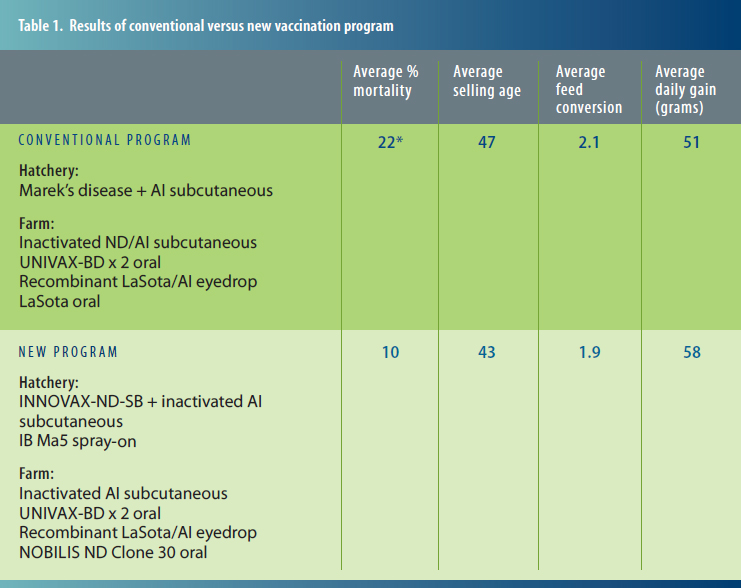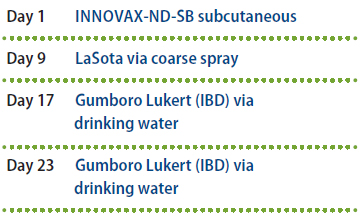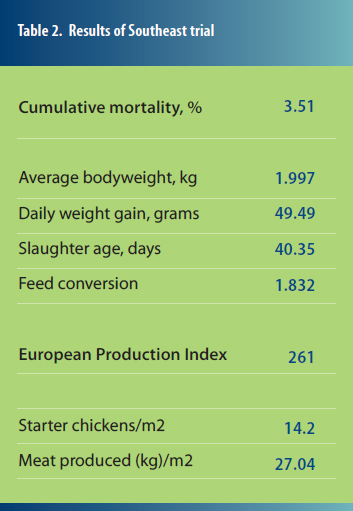
Field experience in Mexico has demonstrated the value of a recombinant vaccine for controlling Newcastle disease — including cases complicated by other types of viral respiratory infection. Problems in Mexico due to Newcastle disease (ND) are much like those in other Latin American countries, says Ángel Mosqueda Taylor, DVM, a veterinary consultant and former professor of poultry diseases at the National Autonomous University in Mexico.
The disease has a significant economic impact because the consequences of ND include mortality, chronic respiratory problems, condemnations and export obstacles.
Excessive field challenge
Controlling ND is difficult for a variety of reasons, including inadequate biosecurity, poor communication among producers, excessive field challenge in some areas and an abundance of backyard birds that are reservoirs for the disease, he explains.
Vaccination programs in Mexico to control ND vary widely, but a typical program might include a live LaSota ND vaccine given with an eyedropper plus an emulsified subcutaneous killed ND vaccine administered at 8 to 12 days, followed by another LaSota vaccine given orally or again by eyedropper at 22 to 25 days. Occasionally, a third LaSota vaccine is given orally at about 35 days of age. In addition, broilers tend to be vaccinated against infectious bronchitis (IB), avian influenza (AI) and, in some cases, infectious laryngotracheitis, Mosqueda says.
In many parts of Mexico, emulsified vaccines against low-pathogenic AI H5N2 are also administered and, for convenience, are often given along with ND vaccines. However, the result is antigen competition, he continues.
New vaccination strategy
More recently, some producers have started using the recombinant vaccine INNOVAX-ND-SB (sold in Mexico as FUSION-ND-SB), which can be given subcutaneously or in ovo. The vaccine was developed to provide immunity against very virulent ND viruses, such as the Mexican Chimalhuacán strain, as well as very virulent strains of Marek’s disease, the veterinarian says.
One of several cases Mosqueda cited showing positive results with use of the recombinant vaccine involved repeated outbreaks of complicated ND on a broiler farm in the Central East region of Mexico. “These were not simple outbreaks; they were complicated by an AI virus, always with Escherichia coli and sometimes with mycoplasma,” Mosqueda adds.
The conventional program had consisted of vaccines for Marek’s disease and an inactivated AI vaccine that were given subcutaneously at the hatchery, followed on the farm by a combined ND/AI emulsified vaccine given subcutaneously, two oral UNIVAX-BD vaccines to protect against infectious bursal disease (IBD), a recombinant LaSota/AI vaccine given by eyedropper and an oral, conventional LaSota.
The new program, which reduced mortality from 24.5% to 5.5%, consisted of INNOVAX-ND-SB plus an inactivated AI vaccine given subcutaneously and an IB Ma5 vaccine administered by coarse spray at the hatchery. Once on the farm, birds received an inactivated AI vaccine given subcutaneously, two oral UNIVAX-BD vaccines, plus a recombinant LaSota/AI vaccine given by eyedropper and a live NOBILIS ND Clone 30 oral vaccine.
More advantages
One of the first advantages seen with INNOVAX-ND-SB vaccine was that it was given separately from the influenza vaccine, which has improved the response to both ND and influenza, he notes.
In another case, the goal of changing the vaccination program was to gain better control of several respiratory diseases on a broiler farm in the Northwest area of Mexico that was located near a chicken manure deposit and commercial layer houses. INNOVAX-ND-SB and the live IB vaccine NOBILIS IB Ma5 were incorporated into the vaccination program, Mosqueda says. The result was lower mortality and better performance (Table 1).

* Mortality due to avian influenza and infectious bronchitis
The new program enabled withdrawal of the second vaccination against ND at 35 days, more effective control of IB and AI, and a reduction in costs incurred due to medication required for respiratory illness.
Southeast field trial
In another flock, INNOVAX ND-SB was used in a trial in the Southeast region. The ND challenge was low and birds were free of AI. The goal was to see if the use of the emulsified ND vaccine could be eliminated. The protocol was as follows:


The results included a low 3.51% mortality in the females and a daily weight gain of 49.49 grams (Table 2).
When the chickens were challenged with the Chimalhuacán ND strain at days 21 and 35, they were 100% protected, compared to 0% protection in a group of unvaccinated, challenged control birds, Mosqueda says.
He concluded that field experience as well as challenge testing demonstrated the value of INNOVAX-ND-SB for managing ND. The vaccine also has value as an alternative to the use of subcutaneous ND emulsified vaccines, which have to be individually applied at the farm, affecting biosecurity as well as management.
Mosqueda emphasizes, however, that “for vaccines to work at their utmost ability, they need help. Bird susceptibility and the field challenge need to be reduced. Remember, the success of a vaccine partly depends on how it is placed inside your vaccination program.”
More Issues









